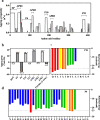Peptides derived from gp43, the most antigenic protein from Paracoccidioides brasiliensis, form amyloid fibrils in vitro: implications for vaccine development
- PMID: 34873233
- PMCID: PMC8648789
- DOI: 10.1038/s41598-021-02898-5
Peptides derived from gp43, the most antigenic protein from Paracoccidioides brasiliensis, form amyloid fibrils in vitro: implications for vaccine development
Abstract
Fungal infection is an important health problem in Latin America, and in Brazil in particular. Paracoccidioides (mainly P. brasiliensis and P. lutzii) is responsible for paracoccidioidomycosis, a disease that affects mainly the lungs. The glycoprotein gp43 is involved in fungi adhesion to epithelial cells, which makes this protein an interesting target of study. A specific stretch of 15 amino acids that spans the region 181-195 (named P10) of gp43 is an important epitope of gp43 that is being envisioned as a vaccine candidate. Here we show that synthetic P10 forms typical amyloid aggregates in solution in very short times, a property that could hamper vaccine development. Seeds obtained by fragmentation of P10 fibrils were able to induce the aggregation of P4, but not P23, two other peptides derived from gp43. In silico analysis revealed several regions within the P10 sequence that can form amyloid with steric zipper architecture. Besides, in-silico proteolysis studies with gp43 revealed that aggregation-prone, P10-like peptides could be generated by several proteases, which suggests that P10 could be formed under physiological conditions. Considering our data in the context of a potential vaccine development, we redesigned the sequence of P10, maintaining the antigenic region (HTLAIR), but drastically reducing its aggregation propensity.
© 2021. The Author(s).
Conflict of interest statement
The authors declare no competing interests.
Figures





Similar articles
-
Paracoccidioides brasiliensis vaccine formulations based on the gp43-derived P10 sequence and the Salmonella enterica FliC flagellin.Infect Immun. 2009 Apr;77(4):1700-7. doi: 10.1128/IAI.01470-08. Epub 2009 Feb 9. Infect Immun. 2009. PMID: 19204092 Free PMC article.
-
Attempts at a peptide vaccine against paracoccidioidomycosis, adjuvant to chemotherapy.Mycopathologia. 2008 Apr-May;165(4-5):341-52. doi: 10.1007/s11046-007-9056-1. Mycopathologia. 2008. PMID: 18777638 Review.
-
Mapping of the T-cell epitope in the major 43-kilodalton glycoprotein of Paracoccidioides brasiliensis which induces a Th-1 response protective against fungal infection in BALB/c mice.Infect Immun. 1998 Feb;66(2):786-93. doi: 10.1128/IAI.66.2.786-793.1998. Infect Immun. 1998. PMID: 9453642 Free PMC article.
-
Recombinant vaccines of a CD4+ T-cell epitope promote efficient control of Paracoccidioides brasiliensis burden by restraining primary organ infection.PLoS Negl Trop Dis. 2017 Sep 22;11(9):e0005927. doi: 10.1371/journal.pntd.0005927. eCollection 2017 Sep. PLoS Negl Trop Dis. 2017. PMID: 28938005 Free PMC article.
-
PARACOCCIDIOIDOMYCOSIS: CHALLENGES IN THE DEVELOPMENT OF A VACCINE AGAINST AN ENDEMIC MYCOSIS IN THE AMERICAS.Rev Inst Med Trop Sao Paulo. 2015 Sep;57 Suppl 19(Suppl 19):21-4. doi: 10.1590/S0036-46652015000700005. Rev Inst Med Trop Sao Paulo. 2015. PMID: 26465365 Free PMC article. Review.
Cited by
-
Unraveling the Nano World in Paracoccidioidomycosis: Promising Applications of Nanotechnology in Diagnosis, Treatment, and Vaccines: A Mini Review.Curr Microbiol. 2025 Apr 28;82(6):264. doi: 10.1007/s00284-025-04251-9. Curr Microbiol. 2025. PMID: 40295332 Review.
-
LambdaPP: Fast and accessible protein-specific phenotype predictions.Protein Sci. 2023 Jan;32(1):e4524. doi: 10.1002/pro.4524. Protein Sci. 2023. PMID: 36454227 Free PMC article.
-
Connection between MHC class II binding and aggregation propensity: The antigenic peptide 10 of Paracoccidioides brasiliensis as a benchmark study.Comput Struct Biotechnol J. 2023 Feb 18;21:1746-1758. doi: 10.1016/j.csbj.2023.02.031. eCollection 2023. Comput Struct Biotechnol J. 2023. PMID: 36890879 Free PMC article.
References
-
- Cordova L. A., Torres J. Paracoccidioidomycosis in StatPearls. (StatPearls Publishing, 2021). - PubMed
Publication types
MeSH terms
Substances
LinkOut - more resources
Full Text Sources

